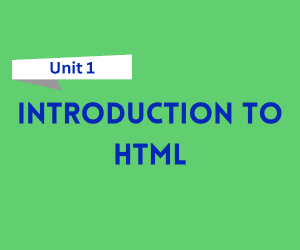
Free Download Introduction to HTML Notes in pdf – Bca 3rd Semester. High quality, well-structured and Standard Notes that are easy to remember.
Click on the Download Button 👇
Introduction to HTML
HTML (HyperText Markup Language) is the standard markup language used to create and design web pages. It provides the structure and foundation of web content, allowing users to add text, images, links, multimedia, and more to a webpage. HTML, initially developed by Tim Berners-Lee in 1993, has evolved significantly and is now in its latest version, HTML5. Its simplicity, coupled with its versatility, makes HTML the backbone of the World Wide Web.
Key Points
- Definition: HTML stands for HyperText Markup Language and is used to define the structure of web pages.
- Structure: An HTML document comprises elements such as headings, paragraphs, lists, links, and multimedia.
- HTML Tags: Tags, enclosed in angle brackets (
< >), define elements in HTML (e.g.,<p>for a paragraph). - Attributes: Tags often include attributes to add additional functionality or style, such as
id,class, orsrc. - HTML Versions: From HTML 2.0 to the latest HTML5, each version introduced new features and improved capabilities.
- Cross-Browser Compatibility: HTML ensures websites are accessible across different browsers and devices.
- Client-Side Language: HTML is processed by the browser, making it a client-side language.
Features of HTML
Simplicity
HTML is easy to learn and use, making it suitable for beginners and experts alike.Platform Independence
HTML is compatible across all platforms and browsers, ensuring universal accessibility.Multimedia Support
HTML supports embedding images, audio, video, and other multimedia formats, enhancing user engagement.Hyperlinking
HTML facilitates linking between web pages or external resources, creating a network of interrelated information.Semantic Elements
HTML5 introduced semantic elements like<header>,<footer>,<article>, and<section>for better readability and SEO optimization.Responsive Design
HTML combined with CSS allows for responsive web design, ensuring compatibility across devices.Integration with Other Technologies
HTML seamlessly integrates with CSS, JavaScript, and other web technologies for advanced functionality.Document Structure
HTML organizes content in a hierarchical structure using tags like<html>,<head>, and<body>.
FAQs on HTML
1. What is the purpose of HTML?
HTML structures and formats web content, enabling browsers to display it effectively.
2. What are HTML tags and elements?
Tags are the building blocks of HTML, enclosed within < >. An element is the complete structure, including the opening tag, content, and closing tag. Example: <p>Hello World</p>.
3. What is the difference between HTML and CSS?
HTML defines the structure of a webpage, while CSS (Cascading Style Sheets) styles and designs the appearance of HTML elements.
4. Can HTML be used to create dynamic web pages?
HTML itself is static. To create dynamic web pages, it is combined with JavaScript or server-side programming languages like PHP.
5. What is the latest version of HTML, and why is it important?
The latest version is HTML5. It introduced features like multimedia support, semantic tags, and improved performance, making web development more efficient.
6. Is HTML case-sensitive?
No, HTML is not case-sensitive. For example, <TITLE> and <title> are treated the same. However, it’s recommended to use lowercase for consistency.
7. What are semantic elements in HTML?
Semantic elements clearly describe their purpose and content. Examples include <header> for page headers, <article> for articles, and <footer> for footers.
8. How do you embed multimedia in HTML?
Multimedia can be embedded using tags like <img> for images, <audio> for audio, and <video> for video files.
9. What are empty tags in HTML?
Empty tags do not have closing tags or content inside them. Examples include <img>, <br>, and <hr>.
10. How does HTML support SEO?
Semantic elements, headings, alt attributes for images, and proper use of meta tags in HTML improve a website’s SEO ranking.